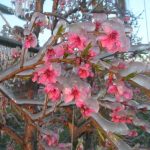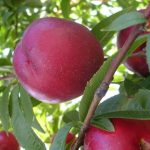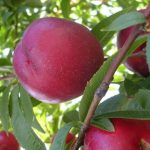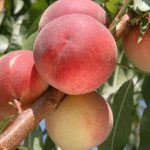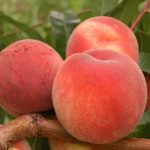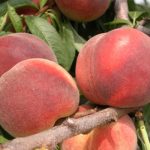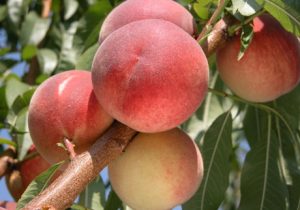
Name
Peach of Cuneo
Seal of quality
Prodotto Agroalimentare Tradizionale (PAT) / Typical food-farming product.
Description
There is a wide range of peach varieties produced in the province of Cuneo , predominantly a smooth skin variety (nectarines) with yellow flesh. The production calendar extends from July to September thanks to the cultivation of different groups.
The area of production concerns two areas, which differ in productive methods and the varieties cultivated: the flatland strip, the centre of which is the Commune of Saluzzo and the hilly belt of Roero. In the first area, cultivation is carried out in highly specialised fruit orchards provided with systems protecting from hailstone and frost and of localised irrigation where recently developed vaieties are cultivated. The range of variety in this area is dominated by the yellow-flesh nectarine variety.
In the hilly Roero area, on the contrary, cultivation is carried out according to tradition, on downward well-exposed slopes where irrigation is impossible. As far as variety is concerned, the cultivars with hairy skin and yellow flesh dominate. In this area, efforts are being made to bring back old varieties once cultivated in this area.
Nutritional Characteristics
Follows the nutritional characteristics of Peaches.
| FOOD | unit of measurement | Pesche con buccia | Pesche senza buccia |
|---|---|---|---|
| Edible part | % | 91 | |
| Water | g | 90,7 | |
| Protein | g | 0,7 | 0,8 |
| Fat | g | tr | 0,1 |
| Carbohydrates | g | 5,8 | 6,1 |
| Starch | g | 0 | 0 |
| Soluble sugar | g | 5,8 | 6,1 |
| Total fibre | g | 1,9 | 1,6 |
| Energy | kcal | 25 | 27 |
| Kilojoules | kJ | 103 | 113 |
| Sodium | mg | 3 | |
| Potassium | mg | 260 | |
| Iron | mg | 0,4 | |
| Calcium | mg | 8 | |
| Phosphor | mg | 20 | |
| Thiamine | mg | 0,01 | |
| Riboflavin | mg | 0,03 | |
| Niacin | mg | 0,5 | |
| Vit A ret. eq. | mcg | 27 | |
| Vit C | mg | 4 | |
| Vit E | mg |
Area of production
Peach cultivation is extremely widespread in the province of Cuneo , and a distinction can be made between two areas of production:
- the belt of flatlands the centre of which is Saluzzo and extends as far as Cuneo, the chief city;
- the Roero belt which concerns the areas adjacent to the commune of Canale.
History
Origin of cultivation in the Saluzzo region
The first implantations in the Saluzzo region took place in 1927, thanks to the work of some far-sighted farmers in the Lagnasco area. In a short time, a group of confident fruit growers came together and revived the sector, and were a good example to other farmers who began cultivating the peaches. As regards variety, the only cultivar to be known then was the Hale, which was intervalled by implantation of Elberta trees, indispensable for fecundation. There was an incredible increase in land invested and in 1948 Lagnasco could already boast a fair dedicated to peach cultivation. The land increase was accompanied by a culture evolution as far as variety was concerned, with the introduction of new cultivars such as Impero and Michelini and, recently, variety renewal, particularly impressive in this area, has determined the replacement of peaches with nectarines, especially the yellow flesh variety.
Origin of cultivation in the Bra region
The Bra area was the first area in the province to experience the cultivation of peaches. In fact, in this area, industrial peach growing began around 1885. That year, the lawyer Ettore Ferrio from Vezza d’Alba, concerned about the sorry state local viniculture was in because of the frequent hailstorms and the invasion of blight, conceived the idea of specialised peach growing based on early varieties. Therefore he implanted 70 – 80 ares close to the Chief Town, with a predominance of Amsden and Rossa di Maggio di Brig. The results were so surprising that he immediately began to acitively publicise this culture, distributing at the same time numerous buds for grafting. Hence, a little at a time, the specialised cultivation of peaches spread in just a few years to the communes of Canale and Cornegliano, then to Bra, and also to the Langa area on the right side of the Tanaro. In the last ten years, there has been a reduction in land invested for peach growing, as this, from an economical point of view, is hardly competitive with respect to more modern tableland fruit growing. In the last few years, there has been a revival of the culture and of the varieties cultivated in the past, thanks to some determined farmers who have joined in defence activities.
